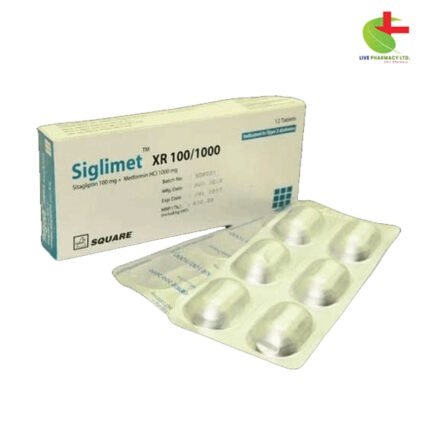Siglimet 50/1000
96.00৳ Strip
- Discover our comprehensive approach to managing type 2 diabetes with a specialized combination tablet of sitagliptin and metformin.
- Designed to improve glycemic control in adults, alongside diet and exercise.
- Explore dosage guidelines, pharmacological insights, and important safety information.
- Empowering your health decisions with effective antihyperglycemic agents.
 Brand
Brand
|
Square Pharmaceuticals PLC |
|---|---|
 Generics
Generics
|
Sitagliptin + Metformin Hydrochloride |
Indications
This medication serves as an adjunct to diet and exercise for improving glycemic control in adults with type 2 diabetes mellitus when treatment with both sitagliptin and metformin is appropriate. It is important to note:
- Limitations: This medication is not suitable for patients with type 1 diabetes or for treating diabetic ketoacidosis, as it is ineffective in these conditions.
- Pancreatitis: There is no specific study on patients with a history of pancreatitis; therefore, caution is advised as the risk of pancreatitis while using this medication is unknown.
Pharmacology
This tablet combines two antihyperglycemic agents with complementary mechanisms of action to enhance glycemic control in type 2 diabetes patients. Sitagliptin, a dipeptidyl peptidase-4 (DPP-4) inhibitor, slows down the inactivation of incretin hormones like GLP-1 and GIP. These hormones regulate glucose levels by stimulating insulin release and reducing glucagon secretion. Metformin HCl, a biguanide, works differently by decreasing hepatic glucose production, reducing intestinal glucose absorption, and enhancing peripheral glucose utilization.
Dosage & Administration
- Film-coated tablet: The dosage should be individualized based on the patient’s current regimen, effectiveness, and tolerability, not exceeding 100 mg sitagliptin and 2000 mg metformin daily. It is typically administered twice daily with meals, starting with a lower dose to minimize gastrointestinal side effects associated with metformin.
- Extended-release tablet: Administered once daily with the evening meal, with gradual dose escalation to manage metformin-related gastrointestinal effects. The total daily dose should not exceed 100 mg sitagliptin and 2000 mg metformin extended-release.
Interactions
Use caution when using this medication with cationic drugs eliminated via renal tubular secretion. Additionally, monitor patients closely when co-administering with drugs like phenprocoumon or levothyroxine, as interactions may occur.
Contraindications
This tablet is contraindicated in patients with renal disease or dysfunction, acute or chronic metabolic acidosis (including diabetic ketoacidosis), and a history of serious hypersensitivity reactions to the medication.
Side Effects
Common adverse reactions may include diarrhea, upper respiratory tract infection, and headache, particularly when starting treatment.
Pregnancy & Lactation
Use during pregnancy should be considered only if clearly needed, as the safety of this medication in pregnant women has not been established. Exercise caution when administering to nursing women due to potential excretion into human milk.
Precautions & Warnings
- Lactic Acidosis: Monitor patients for signs of lactic acidosis, especially in those with predisposing factors such as renal impairment or sepsis.
- Hypothyroidism: Regularly assess thyroid function in patients with hypothyroidism due to potential interactions with metformin.
- Renal Function: Assess renal function before initiating therapy and periodically thereafter to detect any abnormalities.
Overdose Effects
In case of overdose, employ supportive measures appropriate to the patient’s clinical status. Sitagliptin and metformin have specific considerations for overdose management, including potential dialyzability.
Therapeutic Class
This medication belongs to the therapeutic class of combination oral hypoglycemic preparations.
Storage Conditions
Store below 25°C in a dry place away from light, and ensure it is kept out of reach of children. Only dispense this medication under the prescription of a registered physician and do not use beyond the expiry date.













Reviews
There are no reviews yet.